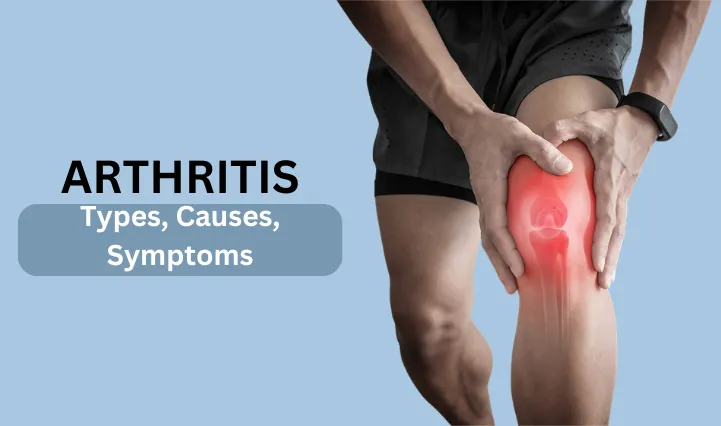Arthritis (गठिया या जोड़ो का दर्द): Types, Causes, Symptoms
Arthritis (गठिया या जोड़ो का दर्द) is a medical term broadly used to refer to joint inflammation. It can cause pain, difficulty moving, and stiffness in one or more joints. There are various forms of arthritis, and it is one of the leading causes of disability worldwide. Each form of arthritis has a specific treatment plan.
Different Forms of Arthritis
While there are various types of arthritis, this article will discuss some of the common ones. The common ones are osteoarthritis, rheumatoid arthritis, psoriatic arthritis, Gout, Ankylosing Spondylitis, and juvenile arthritis.
1. Osteoarthritis (OA)
This is also referred to as wear and tear arthritis. It is caused by the breakdown of the cartilage (the cushion between the bones). The symptoms are loss of flexibility, stiffness, swelling, and pain. It commonly affects the hips, knees, hands, and spine. People who are aging and obese are genetically predisposed to the disease and previous joint injuries.
The treatments for this type of arthritis include –
- Weight management,
- Physical therapy,
- Pain relievers,
- Joint injections,
- Surgery in severe cases
2. Rheumatoid Arthritis (RA)
This is an autoimmune disease in which the body’s immune system attacks the immune cells that attack the joint lining of the body, leading to inflammation. The symptoms along with joint pain and swelling are fatigue, fever, weight loss, and joint deformities. This commonly affects the smaller joints such as hands, wrists, and feet.
This disease is common in women. People who smoke or are genetically predisposed to this disease. The range of treatments includes –
- Immunosuppressants (Methotrexate)
- Biologics,
- anti-inflammatory medication
- Physical therapy
3. Psoriatic Arthritis (PsA)
This type of arthritis results from an autoimmune disorder linked to psoriasis. This disease commonly affects finger joints, toes, and lower back. The symptoms are pain and swelling in fingers/toes, nail changes, and skin rashes. People with a family history of this disease and autoimmune diseases have a higher risk of being affected by Psoriatic Arthritis (PsA).
The treatment includes –
- Biologic drugs,
- NSAIDs,
- Lifestyle changes.
4. Gout
Gout is another type of arthritis caused by high levels of uric acid in the body. Specifically, it is caused by crystal deposits of uric acid in the joints. The symptoms are sudden, severe pain, redness, and swelling. Gout usually affects the toes, ankles, and knees.
Some of the treatments include –
- Diet changes
- Anti-inflammatory medication
- Medications to reduce the amount of Uric Acid
5. Ankylosing Spondylitis (AS)
AS is also known as arthritis of the spine. It is caused by chronic inflammation of the spine and sacroiliac joints. It most commonly affects the spine, pelvis, and shoulders. Symptoms include lower back pain, stiffness, and difficulty moving. Genetics and the HLA-B27 gene are risk factors. This disease is common in males.
The treatment for this type of arthritis includes
- Physical therapy,
- NSAIDs,
- Biologics.
6. Juvenile Arthritis (JA)
Arthritis can be caused in children as a result of autoimmune disease. The symptoms include swollen, painful joints, fever, and rash. It commonly affects the hands, feet, and knees. It is caused due to genetics and autoimmune triggers. The treatment includes NSAIDs, corticosteroids, and disease-modifying drugs.
Some of the most common ways in which arthritis is diagnosed are Blood tests, x-rays, CT Scans, and joint aspiration tests.
1. Blood Tests – These tests are used to test for inflammatory markers such as CRP, ESR, and autoantibodies like rheumatoid factor for RA.
2. X-rays: These candles are used to show joint damage, bone loss, and cartilage wear.
3. MRI & CT Scans – This is done to see detailed images of soft tissues, cartilage, and bones.
4. Joint Aspiration (Synovial Fluid Analysis) – This test is primarily used for Gout, and the test is done by extracting fluid from the joint to check for infection or uric acid crystals.
Treatment of Arthritis
There are various treatments for arthritis available and range from medication to lifestyle changes to surgery. The list of medications that help treat and manage arthritis includes pain relievers such as Acetaminophen, NSAIDs (Ibuprofen, Naproxen), Corticosteroids and DMARDs (Disease-Modifying Antirheumatic Drugs), biologics that target the immune system, and uric acid lowering drugs.
The second way is to manage through physical therapy and exercise. These can be coupled with lifestyle and home remedies. For severe cases, surgery is an option.
Lifestyle Changes To Reduce the Risk Of Arthritis
There are a few lifestyle changes that can be done to reduce the chances of getting arthritis. These are –
- Maintain a healthy weight.
- Stay active with regular exercise.
- Protect your joints (avoid repetitive stress and use ergonomic tools).
- Eat an anti-inflammatory diet.
- Avoid smoking and excessive alcohol.

